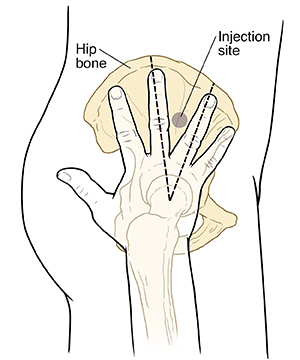Discharge Instructions: Giving an Intramuscular (IM) Injection in the Hip
Your healthcare provider has prescribed a medicine that must be given by intramuscular (IM) injection. IM injections use a needle and syringe to send medicine to large muscles in your body. They are usually given in the thigh, hip, or upper arm.
You were shown how to do an IM injection in the hospital. If you did not get an instruction sheet covering those general steps, ask for one. This sheet reminds you or your caregiver how to give an IM injection in the hip. Another person must help you with this injection.
Name of your medicine: _______________________________.
Amount per injection: _________________________________.
Times per day: ______________________________________.
Number of days: ______________________________________
Step 1. Getting ready
-
Gather your supplies.
-
Wash your hands well with soap and clean water or alcohol-based hand sanitizer. The person who is helping you must also wash their hands well.
-
Prepare your medicine as you were shown by your healthcare provider.
Step 2. Finding an injection site
The person who is helping you can find an injection site on your hip by doing the following:
-
The other person will find the place where your thighbone meets your hip. This is a bony, ball-like area. The other person will place the palm of their hand over this bony area.
-
The other person’s fingers should point toward the ceiling. Then they will make a V with the ring finger and middle finger.
-
The bottom point of the V is where the other person’s ring finger and middle finger meet.
-
The injection site will be between the knuckles on the other person’s ring finger and middle finger. This is where the needle will be inserted.
-
The other person will prepare the injection site as you were shown by your healthcare provider. (See the general instruction sheet on giving yourself an IM injection. If you did not get this sheet, ask for one.)

Step 3. Injecting the medicine
-
The other person will stretch your skin tight.
-
The other person will hold the syringe like a pencil. Then they will insert the needle straight into your skin.
-
You may be told by your healthcare provider to have the person giving you the injection pull back slightly on the plunger. This is to make sure they did not hit a blood vessel with the needle. If blood appears in the syringe, remove the needle and don't inject the medicine. It might go into the bloodstream and not the muscle. Dispose of the needle and syringe in a sharps container and repeat the process in a different spot on your hip.
-
To inject the medicine, the other person will push down on the plunger at a steady rate.
-
You should have no more than 5 mL of medicine in this site. If the prescribed dose is more than 5 mL, choose a different site to inject the medicine.
Step 4. Removing the needle
-
The other person will remove the needle and syringe outward, away from your body.
-
They will let go of your skin.
Step 5. After the injection
-
You or the other person can press a gauze pad onto the site.
-
Hold the pad tightly for a minute.
-
Check the area for redness, bleeding, or bruising.
-
Apply a bandage to the site, if needed.
-
The other person will put the needle and syringe in a special container (sharps container).
-
Dispose of the other materials as you were shown by your healthcare provider.
-
Wash your hands well. The person who is helping you must also wash their hands well.
Medicine that comes in a container for a single dose should be used only 1 time . If you use it a second time, it may have germs that can cause infections. These infections usually affect the skin and soft tissues. But some infections can affect the brain, spinal cord, or heart. Sharing another person's used needles or medicines can cause other infections, such as hepatitis B and hepatitis C.
Follow-up care
Follow up with your healthcare provider, or as advised.
When to call your healthcare provider
Call your healthcare provider right away if you have any of the following:
-
Needle that breaks off at the injection site
-
Problems that keep you from getting the injection
-
Bleeding or severe pain at the injection site that won’t stop
-
Medicine injected into the wrong area
-
Rash or swelling at the injection site
-
Shortness of breath
-
Fever above 100.4°F ( 38.0°C ), or as directed by your healthcare provider
Online Medical Reviewer:
Eric Perez MD
Online Medical Reviewer:
Jessica Gotwals RN BSN MPH
Online Medical Reviewer:
Paula Goode RN BSN MSN
Date Last Reviewed:
2/1/2022
© 2000-2024 The StayWell Company, LLC. All rights reserved. This information is not intended as a substitute for professional medical care. Always follow your healthcare professional's instructions.